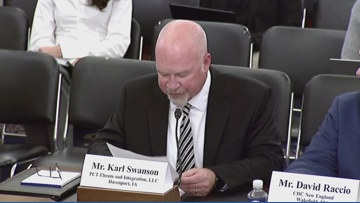Report on the Plutonium Workforce Development Initiative and its Alignment with Sustainable Development Goals
Executive Summary
This report details the Plutonium Workforce Development Initiative (PWDI), a collaborative effort in New Mexico aimed at creating a skilled workforce for the Los Alamos National Laboratory (LANL). The initiative, involving ten higher education institutions led by New Mexico State University (NMSU), demonstrates a strong alignment with several United Nations Sustainable Development Goals (SDGs), particularly in the areas of quality education, economic growth, infrastructure development, and strategic partnerships.
SDG 4: Quality Education
The PWDI directly supports SDG 4 by investing in inclusive and equitable quality education and promoting lifelong learning opportunities. The program enhances the educational capacity of New Mexico’s higher education institutions.
- Direct Investment: Of the $18 million appropriated by the National Nuclear Security Administration, NMSU has received over $4.5 million to enhance its educational programs.
- Broad Institutional Reach: The initiative extends beyond NMSU, involving a total of ten higher education institutions, thereby strengthening the state’s overall educational ecosystem. Participating institutions include:
- New Mexico State University
- University of New Mexico
- New Mexico Tech
- Navajo Technical University
- New Mexico Highlands University
- Northern New Mexico College
- Central New Mexico Community College
- San Juan College
- Santa Fe Community College
- Luna Community College
- Interdisciplinary Training: The program supports a wide range of academic departments, including chemistry, physics, and various engineering disciplines, ensuring students receive comprehensive and relevant training.
SDG 8: Decent Work and Economic Growth
The initiative is a direct driver for SDG 8, promoting sustained, inclusive, and sustainable economic growth, full and productive employment, and decent work for all. It establishes a clear pipeline from education to high-skilled employment.
- Workforce Pipeline: The primary objective is to create a sustainable workforce pipeline to support LANL’s pit manufacturing mission, ensuring long-term job security and economic stability in the region.
- Diverse Employment Opportunities: The program prepares students for a wide array of professional and technical roles. According to Vimal Chaitanya, the PWDI’s statewide program director, the workforce needs include:
- Welders and Machinists
- Radiation and Nuclear Scientists
- Materials, Mechanical, and Nuclear Engineers
- Supply Chain and Project Managers
- Accountants and Procurement Agents
SDG 9: Industry, Innovation, and Infrastructure
By funding the acquisition of modern equipment and facilities, the PWDI contributes to SDG 9, which aims to build resilient infrastructure, promote inclusive and sustainable industrialization, and foster innovation.
- Infrastructure Enhancement: The funding has enabled participating universities to purchase equipment they could not otherwise afford, building critical infrastructure for advanced research and training.
- Increased Competitiveness: This enhanced infrastructure makes the universities more competitive for future federal funding opportunities.
- Broad Application: The new facilities and equipment are not limited to training for LANL; they can be used to prepare students for a variety of other jobs, promoting overall economic and technological advancement at a national level.
SDG 17: Partnerships for the Goals
The structure of the PWDI exemplifies SDG 17, which stresses the importance of multi-stakeholder partnerships to achieve sustainable development.
- Collaborative Framework: The initiative is a partnership between government bodies, national laboratories, and educational institutions.
- Key Partners:
- Government: The National Nuclear Security Administration provides funding and oversight.
- Consortium: The New Mexico Consortium coordinates the statewide effort.
- Industry: Los Alamos National Laboratory is the primary employer and mission partner.
- Academia: Ten higher education institutions provide the necessary education and training.
- Synergistic Outcomes: This partnership model ensures that educational programs are directly aligned with industry needs, maximizing the efficiency and impact of the investment for the benefit of the state and its workforce.
1. Which SDGs are addressed or connected to the issues highlighted in the article?
The article on the Plutonium Workforce Development Initiative (PWDI) addresses and connects to several Sustainable Development Goals (SDGs) by focusing on education, job creation, infrastructure development, and partnerships, all within the context of a national security mission.
-
SDG 4: Quality Education
The core of the article revolves around creating educational and training opportunities. The PWDI funds ten higher education institutions in New Mexico to “teach and training students in several disciplines” to prepare them for specialized jobs.
-
SDG 8: Decent Work and Economic Growth
The initiative’s primary goal is to “create a robust workforce pipeline” for the Los Alamos National Laboratory (LANL). This directly relates to creating skilled employment opportunities and fostering economic growth in the state by training a workforce for high-demand jobs.
-
SDG 9: Industry, Innovation, and Infrastructure
The article highlights that the funding allows universities to purchase new equipment, thereby “building infrastructure at these universities.” This investment enhances their technological and research capabilities, making them “more competitive in terms of federal funding” and fostering innovation beyond the immediate needs of LANL.
-
SDG 17: Partnerships for the Goals
The PWDI is a clear example of a multi-stakeholder partnership. It involves a federal government agency (National Nuclear Security Administration), a national laboratory (LANL), and a consortium of public higher education institutions, all collaborating to achieve a common workforce development goal.
-
SDG 16: Peace, Justice and Strong Institutions
The article connects the initiative to national security, stating that the purpose of the workforce is to assist in LANL’s “pit manufacturing mission, essentially refurbishing the plutonium warheads.” The stated goal is to “keep this arsenal as a deterrent,” which, from the perspective of the article, contributes to maintaining peace and security.
2. What specific targets under those SDGs can be identified based on the article’s content?
Based on the activities described in the article, several specific SDG targets can be identified:
-
SDG 4: Quality Education
- Target 4.3: By 2030, ensure equal access for all women and men to affordable and quality technical, vocational and tertiary education, including university. The article describes a program that provides funding to 10 higher education institutions, including universities and community colleges, to offer specialized training.
- Target 4.4: By 2030, substantially increase the number of youth and adults who have relevant skills, including technical and vocational skills, for employment, decent jobs and entrepreneurship. The initiative is explicitly designed to provide students with relevant skills in fields like “welders and machinists to radiation and nuclear scientists, materials, mechanical and nuclear engineers” for direct employment at LANL.
-
SDG 8: Decent Work and Economic Growth
- Target 8.6: By 2020, substantially reduce the proportion of youth not in employment, education or training. The program directly tackles this by creating a clear pathway from education and training into employment for the youth of New Mexico.
-
SDG 9: Industry, Innovation, and Infrastructure
- Target 9.5: Enhance scientific research, upgrade the technological capabilities of industrial sectors… The article states the program is “building infrastructure at these universities” through the purchase of equipment, which will “make our universities more competitive in terms of federal funding” and enhance their research capabilities.
-
SDG 16: Peace, Justice and Strong Institutions
- Target 16.1: Significantly reduce all forms of violence and related death rates everywhere. The article’s justification for the program is that the refurbishment of the nuclear arsenal serves as a “deterrent,” which is a strategy aimed at preventing conflict and maintaining peace, thereby contributing to this target from a national security perspective.
-
SDG 17: Partnerships for the Goals
- Target 17.17: Encourage and promote effective public, public-private and civil society partnerships. The PWDI is a partnership between the National Nuclear Security Administration (public), Los Alamos National Laboratory (public/government-funded), and ten state higher education institutions (public), demonstrating a large-scale public-public partnership.
3. Are there any indicators mentioned or implied in the article that can be used to measure progress towards the identified targets?
The article mentions or implies several quantitative and qualitative indicators that can be used to measure progress:
-
For SDG 4 (Targets 4.3 & 4.4)
- Number of participating institutions: The article explicitly states that “10 higher education institutions in the state” are involved.
- Number of students trained: Progress can be measured by the number of students taught and trained through the program, which aims to “create a sustainable pipeline of workforce.”
-
For SDG 8 (Target 8.6)
- Number of people hired: A direct indicator of success is the number of program graduates who are hired into the “workforce that is educated in many disciplines” at LANL.
-
For SDG 9 (Target 9.5)
- Financial investment in infrastructure: The article provides specific figures, such as the “$18 million appropriated so far” and the “more than $4.5 million” garnered by NMSU, which can be used as an indicator of investment in research and educational infrastructure.
- Acquisition of new equipment: The article mentions the “purchase of equipment that they wouldn’t have been able to do otherwise” as a key outcome.
-
For SDG 16 (Target 16.1)
- Mission accomplishment: An implied indicator is the successful refurbishment of plutonium warheads, fulfilling LANL’s “pit manufacturing mission” to maintain a credible deterrent.
-
For SDG 17 (Target 17.17)
- Existence and scale of the partnership: The Plutonium Workforce Development Initiative itself, involving a federal agency, a national lab, and a consortium of ten colleges and universities, is a primary indicator.
- Amount of financial resources mobilized: The “$18 million” appropriated through the partnership serves as a key financial indicator.
4. Create a table with three columns titled ‘SDGs, Targets and Indicators” to present the findings from analyzing the article.
| SDGs | Targets | Indicators Identified in Article |
|---|---|---|
| SDG 4: Quality Education | 4.3: Ensure equal access to affordable and quality technical, vocational and tertiary education.
4.4: Increase the number of youth and adults who have relevant skills for employment. |
|
| SDG 8: Decent Work and Economic Growth | 8.6: Reduce the proportion of youth not in employment, education or training. |
|
| SDG 9: Industry, Innovation, and Infrastructure | 9.5: Enhance scientific research and upgrade technological capabilities. |
|
| SDG 16: Peace, Justice and Strong Institutions | 16.1: Significantly reduce all forms of violence. |
|
| SDG 17: Partnerships for the Goals | 17.17: Encourage and promote effective public, public-private and civil society partnerships. |
|
Source: newsroom.nmsu.edu







